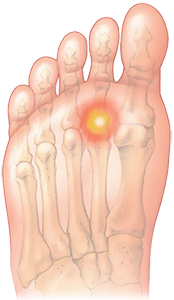Metatarsalgia

Metatarsalgia is a condition where the ball of the foot becomes inflamed and painful. Most commonly found in those who participate in activities such as running and jumping. However, there are additional causes, such as if you wear incorrect fitting shoes and foot deformities.
Metatarsalgia is generally a non-serious condition. However, this disease can catch you off guard. The good thing, most of us can treat this with home remedies such as ice and rest. However, preventing or minimizing problems in the future with this condition is key. Home remedies such as shock-absorbing insoles or arch supports.
Symptoms of the Condition
Symptoms of metatarsalgia include the following:
- Sharp, aching, or burning pain in the ball of your foot — the part of the sole just behind your toes
- Pain that worsens when you stand, run, flex your feet or walk. Especially barefoot on a hard surface, then improving with rest
- A feeling of having a rock in your shoe
- Sharp or shooting pain, numbness, or tingling in your toes
Causes of Metatarsalgia
Although a single factor can lead to this condition, most often there are several factors are involved, such as:
Intense training or activity. Distance runners are at risk of metatarsalgia. Primarily due to the front of the foot that absorbs significant force when a person runs. However, anyone who participates in a high-impact sport is at risk, especially if your shoes fit poorly or are worn.
Specific foot shapes. A high arch can put extra pressure on the metatarsals. Therefore, having a second toe that’s longer than the big toe, causes more weight than normal to be shifted to the second metatarsal.
Deformed feet. Wearing too-small shoes or high heels can cause your foot to be misshapen. A downward-curling toe (hammertoe) and swollen, painful bumps at the base of your big toes (bunions) can also cause metatarsalgia.
Overweight. Because most of your body weight transfers to your forefoot when you move, extra pounds mean more pressure on your metatarsals. Losing weight might reduce or eliminate symptoms.
Incorrect fitting shoes. High heels, which transfer extra weight to the front of your foot, are a common cause of metatarsalgia in women. Shoes with a narrow toe box or athletic shoes that lack support and padding also can contribute to the problem.
Also, see: Is Your Shoe Choice The Reason for Foot Pain?
Stress fractures. Small breaks in the metatarsals or toe bones can be painful and change the way you put weight on your foot. Therefore, stress fractures can cause metatarsalgia.
Morton’s neuroma. This noncancerous growth of fibrous tissue around a nerve usually occurs between the third and fourth metatarsal heads. It causes symptoms that are similar to metatarsalgia and can also contribute to metatarsal stress.
Whos at Risk for Metatarsalgia?
Although almost everyone is at risk for the condition, you may become a higher risk if you:
- Wear high heels. Shoes that fit improperly or with spikes, such as cleats.
- Are active in high-impact sports that involve running and jumping.
- Are obese or overweight.
- Have inflammatory arthritis, such as RA or gout.
- Have current foot problems. These conditions include hammertoe and calluses on the bottom of your feet.
If you suspect you might be experiencing metatarsalgia or another foot condition, call us at 888-409-8006.
